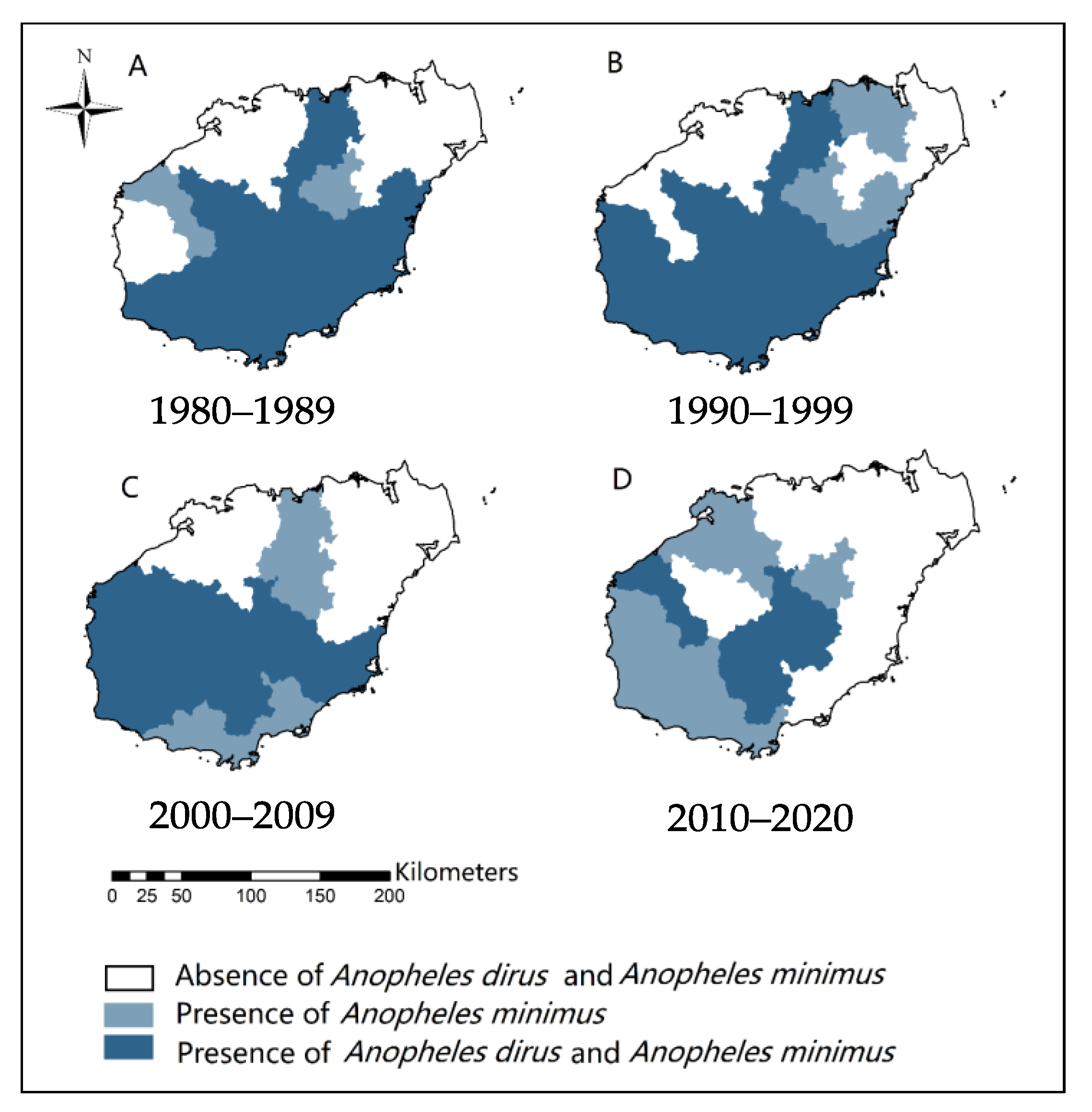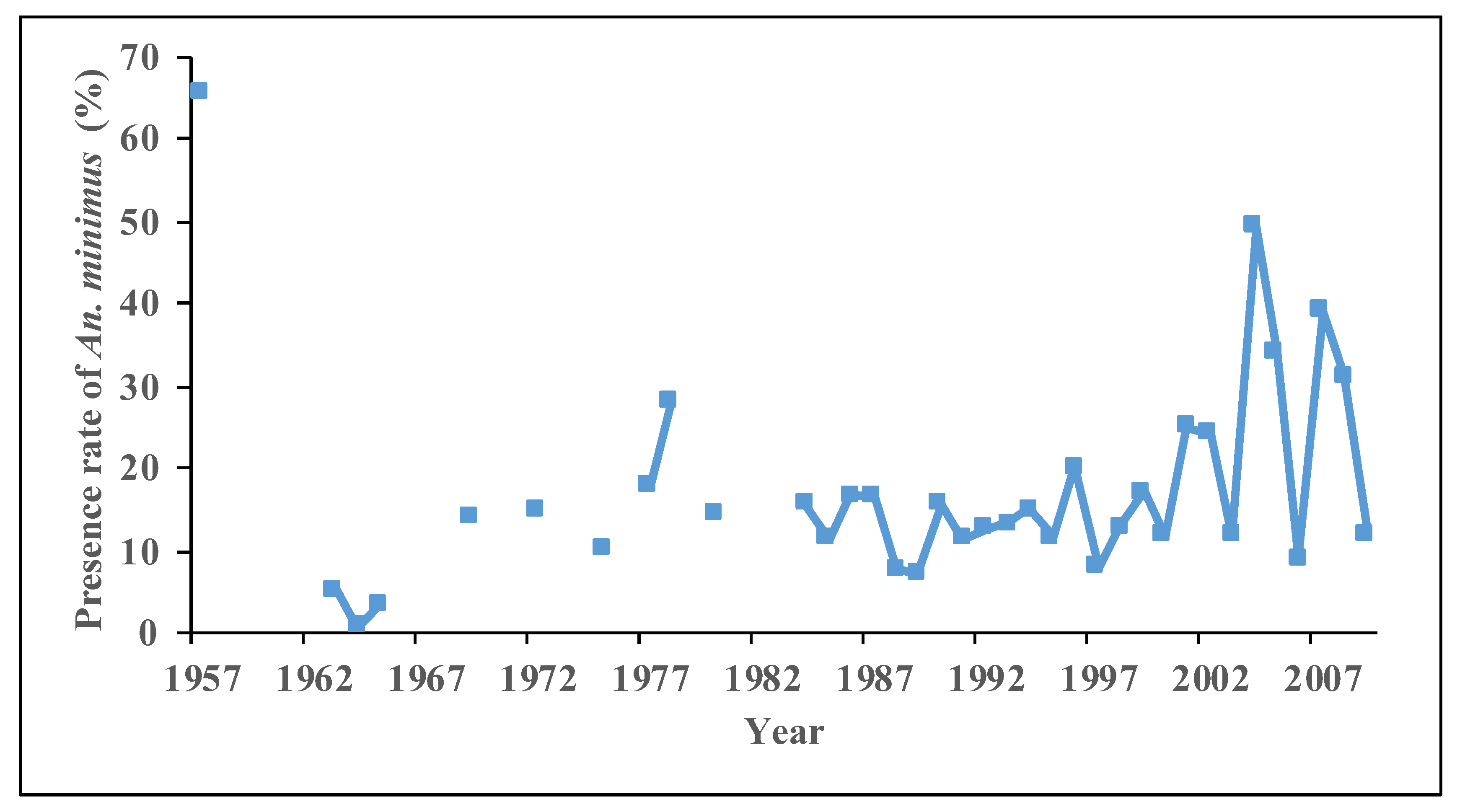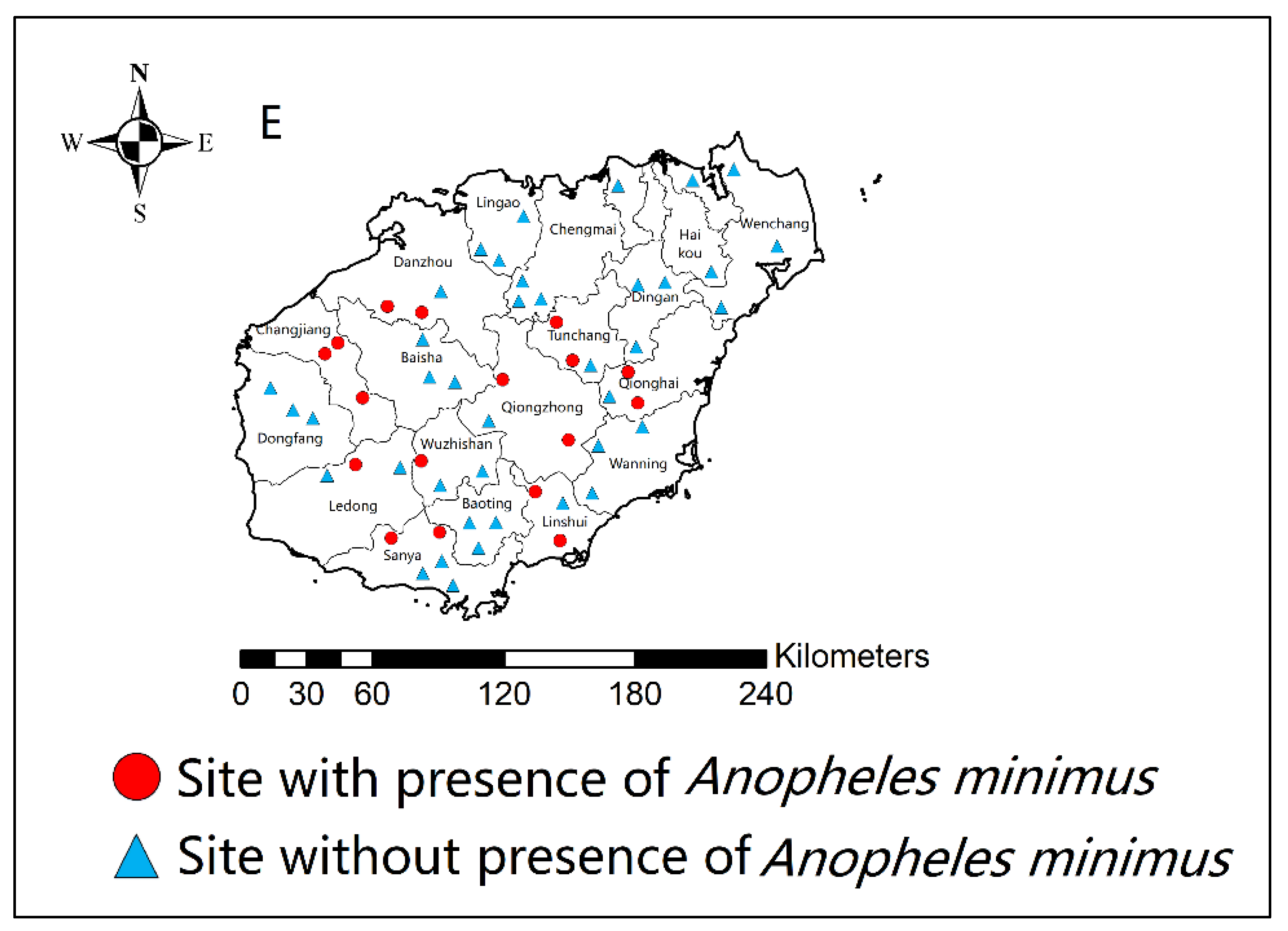You're using an outdated browser. Please upgrade to a modern browser for the best experience.
Please note this is a comparison between Version 2 by Conner Chen and Version 1 by Dingwei SUN.
Malaria is a serious mosquito-borne tropical disease impacting populations in tropical regions across the world. Malaria was previously hyperendemic in Hainan Province. Due to large-scale anti-malarial intervention, malaria elimination in the province was achieved in 2019. Anopheles dirus and Anopheles minimus are primary malaria vectors, mainly distributed in the southern and central areas of Hainan.
- vectors
- research
- Hainan Province
1. Species and Distribution
A total of 32 species of anopheline mosquitoes have been recorded in Hainan Province [10][1]. An. dirus and An. minimus have been confirmed as the principal malaria vectors in Hainan Province, according to a biological investigation of various anopheline mosquitoes and the epidemiological characteristics of malaria. These two species meet all criteria of vector incrimination in Hainan, including (1) evidence that temporal and spatial distribution of local human malaria cases is dependent on An. dirus/An. minimus [4,7,59][2][3][4], (2) evidence of a high degree of anthropophily in An. dirus/An. minimus [7,44,48,57][3][5][6][7], (3) evidence that Plasmodium sporozoites can be harbored in the salivary glands of An. dirus/An. minimus under natural conditions [4[2][3][6][8],7,16,48], and (4) evidence that the Plasmodium parasite harbored by An. dirus/An. minimus can be transmitted under experimental conditions [49,50,51][9][10][11].
An. sinensis, An. candidiensisand and An. philippinensis harbor malaria sporozoites in their salivary glands in Hainan, with sporozoite rates of 0.02, 0.21, and 0.06, respectively [7][3]. However, they are considered secondary malaria vectors because they have a lower degree of anthropophily in Hainan.
An. lesteri, one of the main malaria vectors in other provinces in China, is distributed in Wenchang, Haikou, and Wanning. It is not a malaria vector in Hainan, as no malaria sporozoites were found in its salivary glands [8,14,17,42,43,46,47][12][13][14][15][16][17][18].
2. An. dirus
Anopheles dirus s.s. and Anopheles baimaii, belonging to the Anopheles dirus complex, are important malaria vectors [81][19]. Results from previous research indicate that An. dirus in Hainan is a specimen of the species Anopheles dirus s.s. [18,19,26,30][20][21][22][23].
An. dirus is an exophilic mosquito and prefers to suck human blood [82][24]. It accounts for 0.02% to 0.54% of the composition of Anopheles mosquitoes in human rooms in the daytime [82][24]. However, it accounts for 3.8% of the composition of Anopheles mosquitoes when human plus cattle bait was used in the nighttime [7][3].
In Hainan Province, its larvae breed in riverbeds and rocky caves where there is shade, and decaying leaves [7][3]. A survey on the distribution of An. dirus from 1965 to 1975 indicated that An. dirus was mainly distributed in mountainous areas, especially in the south-central part of Hainan Island [11,12,25,26,31,33,34,35,40][22][25][26][27][28][29][30][31][32]. Due to its breeding habits, environmental modifications, such as cutting down shrubbery, or land use change can lead to the reduction in An. dirus [15,18,22,25,28,38,40,41][20][27][32][33][34][35][36][37].
Results on malaria vectors over the last 70 years indicate that the population and distribution of An. dirus are decreasing [5,15,20,25,28,29,38,40,41][27][32][33][35][36][37][38][39][40]. Longitudinal surveillance in Qiongzhong shows a significant decreasing trend in the population of An. dirus, with 1.67 per night in 2005 to 0.03 per night in 2014 [44][5]. It is now difficult to catch An. dirus at this site. In another surveillance site in Wuzhishan, the population of An. dirus decreased from 1.17 per night in 2005 to 0.33 per night in 2014 [44][5]. Vector surveys during seasonal anti-malarial programs showed a gradual and significant decrease in the presence of An. dirus in Hainan (Figure 31). It means that the spatial distribution of An. dirus is shrinking. The number of cities/counties with An. dirus decreased from 10 in 1981–1990 tofour during 2011–2020 (Figure 42). The decrease in the An. dirus population may lead to the disappearance of this species in certain counties and cities in Hainan. At present, An. dirus is mainly distributed in mountainous areas, including Changjiang, Wuzhishan and Qiongzhong.

Figure 31.
Presence of
Anopheles dirus
in Hainan Province in seasonal anti-malarial programs from 1965 to 2011.

Figure 42. Presence of Anopheles minimus and Anopheles dirus in Hainan Province in seasonal anti-malarial programs from 1980 to 2020. (A) From 1980 to 1989; (B) from 1990 to 1999; (C) from 2000 to 2009; (D) from 2010 to 2020. The light blue color means presence of Anopheles minimus, and the dark blue color means the presence of both kinds of Anopheles.
3. An. minimus
An. minimus can be classified into A and B types in Hainan, based on ecological and morphological surveys and controlled trials [7,57][3][7]. Type A is an endophilic mosquito that prefers to rest in living rooms and is extremely sensitive to DDT [16][8]. However, type B is an exophilic mosquito that prefers to rest outside and avoids surfaces with DDT, but demonstrates excitement when contacting DDT. Results from PCR testing indicated that An. minimus populations from Wenchang and Wanning were An. minimus A [27][41].
An. minimus prefers human and cattle blood. An. miminus is the dominant species of domestic mosquito, accounting for 37.1% of anopheline mosquitoes in human rooms in the daytime [7][3].
An. minimus breeds in clear water bodies, with less humus shaded by plants, such as small streams, slow-flowing rivers, irrigation ditches with water plants, stagnant water in riverbeds, and so on [16][8]. An. minimus was previously widely distributed in mountainous, hilly, and coastal plain areas over the whole province in the 1950s [7,9][3][42].
An. minimus was previously distributed across Hainan Island, but the presence of An. minimus has changed dynamically [10,11,13,15,20,21,23,24,27,28,31,32,33,34,35,36,37,38,39,41,44,45][1][5][25][28][29][30][31][33][35][36][37][39][41][43][44][45][46][47][48][49][50][51]. Since the use of IRS with DDT to control malaria mosquitoes in 1959, the distribution of An. mimimus has shrunk dramatically. A survey from 1963 to 1965 showed that An. minimus had been almost eradicated [3][52]. However, results from a survey in 1978 showed that An. minimus had rebounded (Figure 53) [3,7][3][52]. However, the presence of An. minimus was at a stable rate of 11% to 26% in most years after 1978 (Figure 53). It means that An. minimus is hard to eliminate naturally in a given region although there was a greater improvement in socio-economic development and large-scale implementation of vector control interventions. Vector surveys during the seasonal anti-malarial program from 1980 to 2020 indicate that the percentage of presence of An. minimus at various sites is around 30%, and the number of counties/cities with An. minimus decreased from 12 in 1980–1989 to nine in 2010–2020, mainly distributed in the south-central and western areas of Hainan Province (Figure 42). To further clarify the distribution of An. minimus in Hainan Province, a special survey was conducted throughout the island from 2011 to 2015. Results showed that among 56 survey sites in 18 cities and counties, An. minimus was distributed in 17 survey sites in nine cities/counties (Figure 64). An. minimus was not recorded in coastal plain areas but in hilly and mountainous areas during this survey.

Figure 53.
Presence of
Anopheles minimus
in Hainan Province in seasonal anti-malarial programs from 1965 to 2011.

Figure 64. Presence and absence of Anopheles minimus in Hainan Province from 2011 to 2015. Red circles indicate sites with the presence of Anopheles minimus, while blue triangles indicate sites with the absence of Anopheles minimus.
Studies on the species and distribution of primary malaria vectors are the main research topic in Hainan. In certain areas, data on species and the distribution of primary malaria vectors can provide scientific evidence for the implementation of vector control interventions. Vector control interventions should be implemented to stop malaria transmission in malaria foci with primary vectors. In Hainan, vector control interventions should be implemented to stop malaria transmission when malaria cases are reported in the central and southern mountainous areas of Hainan, where the primary malaria vectors An. minimus and An. dirus are still present.
References
- Cai, X. The checklist of Anopheles mosquitoes in Hainan Island. Hainan Med. 1992, 3, 8–10, 63–64.
- Lin, C.; He, Y.; Tang, D.; Ji, W. Surveillance on Anopheles dirus in malaria hyperendemic areas in Hainan Province (1990–1994). China J. Parasit. Dis. Control 2000, 13, 10–12.
- Hainan Research Institute for Tropical Disease Control and Prevention. Malar. Control Res. Hainan Prov. 1950–1983 1985. Accepted.
- Liao, Z.; He, R.; Han, Y. Observation on the activity of blood sucking of Anopheles dirus in Wangxia Town, Changjiang County, Hainan Province. China Trop. Med. 2004, 4, 665.
- Zeng, L.; Wang, S.; Liu, Y.; Zhao, W.; Li, S.; He, C.; Ou, T. Analysis of the surveillance data about malaria vector in Hainan from 2005 to 2014. China Trop. Med. 2015, 15, 1436–1440.
- Fu, R.; Jiang, G.; Chen, X.; Cai, H.; Zhu, R.; Shi, J.Z.; Wei, J. Observation on the effect of antimalarial intervention of troops stationed in hyperendemic malaria area of Hainan Island. People’s Mil. Surg. 1959, pp. 635–636. Available online: https://kns.cnki.net/kcms2/article/abstract?v=3uoqIhG8C44YLTlOAiTRKth5mPLKqXjbyzE23kHsboPjCjsX8clYAttbVYgdXX7vTl_cS-qLteH6S0Kvfgmgk8UbtGYCCjkU&uniplatform=NZKPT&src=copy (accessed on 18 February 2022).
- Yu, Y.; Fan, B.; Peng, X.; Zeng, L. Observation on the house frequenting behavior and host preference of two forms of Anopheles (Cella) minimus Theobald in Hainan. Acta Entomol. Sin. 1989, 32, 253–254.
- Li, S. Current Research on Anopheles minimus in Hainan. Hainan Med. 1997, pp. 69–71. Available online: https://kns.cnki.net/kcms2/article/abstract?v=3uoqIhG8C44YLTlOAiTRKjkpgKvIT9NkZNmQNo4kSVqXqvOkUzIoTKHb96oi4Gq1OpqBrIXYrk3mt2xSLmIcmLVilsArcwB9&uniplatform=NZKPT&src=copy (accessed on 16 February 2022).
- Song, Z.; Liu, L. Comparison in susceptibility of Anopheles dirus and Anopheles stephensi to a strain of Plasmodium cynomogli. Chin. J. Parasitol. Parasit. Dis. 1989, 7, 201–203.
- Liu, X.; Zheng, X.; Xie, J.; Chen, Z.; Chen, Y.; Zhou, Y.; Li, X. Experimental study on the susceptibility of Anopheles sinensis to Plasmodium vivax in Guizhou. Chin. J. Parasit. Dis. Control 1991, 4, 176–178.
- Song, Z.; Han, W. The infectivity of gametocyts of Plasmodium Cynomolgi B strain to the aged adult of Anopheles dirus. Acta Parasitol. Med. Entomol. 1995, 7, 201.
- Hainan Research Institute for Tropical Disease Control and Prevention. Malar. Control Res. Hainan Prov. 1984–1999 2000. Accepted.
- Fu, F.; Fu, Z.; Feng, C.; Tang, J.; Pang, X.; Si, Y.; Chen, W.; Cai, H. Preliminary observation of the ecological habits of Anopheles anthropophagus in the Nanbeigou, Wenchang. Hainan Med. 1996, 146–147.
- Qian, H.; Pan, J.; Wang, Z.; Ma, C.; Cai, X.; Fu, F.; Fu, Z.; Deng, D. Anopheles lesteri anthropophagus was recorded in Hainan. Chin. J. Parasit. Dis. Control 1992, 9, 122.
- Sun, D.; Wang, F.; Wang, S.; Hu, X.; Wang, G.; Zeng, L.; Li, S.; Cai, H.; Lin, S.; Liu, Y. Distribution of Anopheline mosquitoes (Diptera: Culicidae) in five cities/counties of Hainan Province. China Trop. Med. 2012, 12, 160–162.
- Sun, D.; Wang, S.; Zeng, L.; Li, S.; Zhuo, K. Survey of the diversity of Anopheles species in Hainan Province. J. Pathog. Biol. 2014, 9, 271–274.
- Zhu, Q.; Fu, Y.; Chen, Y.; Chen, L. Investigation of Anophline mosquitoes and evaluation of malaria re-transmitting risk in Haikou. China Trop. Med. 2020, 20, 291–294.
- Zhu, Q.; Fu, Y.; Chen, Y.; Zhong, X. Species, distribution and seasonal fluctuation of Anopheles in Xiuying district of Haikou City. Pr. Prev. Med. 2019, 26, 1453–1455.
- Obsomer, V.; Defourny, P.; Coosemans, M. The Anopheles dirus complex: Spatial distribution and environmental drivers. Malar. J. 2007, 6, 26.
- Qu, F. Biological studies of Anopheles dirus complex: Present situation and prospect. Acta Parasitol. Med. Entomol. 1997, 4, 46–52.
- Qu, F. Current study on taxonomic status of Anopheles dirus and its role in malaria transmission in China. Chin. J. Parasitol. Parasit. Dis. 1998, 16, 230–233.
- Xu, X.; Xu, J.; Qu, F. Differentiation of cryptic species A and D of Anopheles dirus complex by polymerase chain reaction. Chin. J. Parasitol. Parasit. Dis. 1998, 16, 172–175.
- Wang, D.; Ma, Y.; Zhou, H. Genetic variation of Anopheles dirus A and D (Diptera:Culicidae) in China: Inferred by mtDNA-COI gene sequences. Chin. J. Parasitol. Parasit. Dis. 2007, 25, 368–371.
- Sheng, B.; Deng, D.; JL, S.; Huang, Q.; Chen, D.; He, Q. A study of the bionomics of Anopheles leucosphyrus dÖnitz in Hainan Island. Acta Entomol. Sin. 1963, 12, 29–36.
- Cai, X. Current situation and epidemic characteristics of falciparum malaria in South China. Guangxi J. Prev. Med. 1995, 1, 133–135.
- Cai, X. Malaria epidemic situation and control countermeasures in Hainan Province in recent years. J. Dis. Control Prev. 1998, 2, 88–91.
- Wu, K.; Tang, L.; Chen, W.; Liu, D.; Lin, M.; Gu, Z.; Lan, C.; He, Y.; Wang, Z.; Chen, G.; et al. Studies on current characteristics of malaria endemic in mountainous areas of Hainan Province. Chin. J. Parasit. Dis. Control 1998, 11, 241–244.
- Wang, S. Current malaria situation in Hainan Province. J. Pract. Parasit. Dis. 2000, 8, 140.
- Wu, Q.; Cai, Y.; Yang, Y.; Chen, Q.; Wang, Z.; Zeng, L.; Lan, X.; Guo, R.; Qiu, J.; Huang, S.; et al. Investigation on mosquitoes species in Chengmai County, Hainan Province. Hainan Med. 2000, 11, 6–7.
- Yang, J.; Lin, J.; Chen, G. Relationship between distribution area of Anopheles mosquito and malaria prevanlance in Danzhou City, Hainan Province. China J. Vector Biol. Control 2002, 13, 287.
- Zeng, L.; Wang, Z.; Guo, R.; Lan, X. Investigation on Anopheles vectors in malaria foci and high incidence villages in Hainan Province. Hainan Med. 2000, 11, 3–4.
- Lin, M.; Wang, S.; Wen, L.; Zhu, D.; Huang, S.; Tao, Z.; Wang, N.; Xiao, H.; Chen, X. Course of malaria control in half a century and its elimination in Wanning, Hainan. China Trop. Med. 2018, 18, 324–329.
- Han, Y.; Lin, R.; Tang, H. Measures and Effects of Malaria Interventions in Lezhong, Hainan Province, from 1982 to 1997. Hainan Med. 1998, pp. 239–341. Available online: https://kns.cnki.net/kcms2/article/abstract?v=3uoqIhG8C44YLTlOAiTRKjkpgKvIT9Nkm5tS6uBYqSHhAtSA2ROar8kn21vTxjBeHkPln2dnPw3Zyxg7pqnbP66FwpvZAeek&uniplatform=NZKPT&src=copy (accessed on 16 February 2022).
- Wu, K.; Chen, W.; Hu, L.; Cai, X.; Liu, Z.; Zhu, W.; Luo, M.; Guan, D.; Wang, Z.; Tang, Z.; et al. Current malaria situation in Dancounty, Hainan Province. Hainan Med. 1993, 4, 1–4, 64.
- Si, Y.; Luo, P.; Wen, S. Effectiveness of antimalarial interventions in prevention and control pilot in Donghe, Hainan Province. Hainan Med. 2000, 11, 1–2.
- Hu, X.; Zeng, W.; Wang, S.; Wang, G.; Meng, F.; Li, Y. Analysis of malaria surveillance in monitoring sites of Hainan Province from 2006 to 2010. China Trop. Med. 2013, 13, 46–50.
- Lin, M.; Wen, L.; Weng, S.; Li, C.; Tao, Z.; Zhu, D.; Zeng, W.; Huang, S.; Zhang, L.; Chen, X. Effect in implementation of Global Fund Malaria Project in previously high malaria-endemic area of Wanning City. China Trop. Med. 2013, 13, 674–676+683.
- Chen, W.; Wu, K.; Lin, M.; Li, C. Great achievements of anti-malaria for a half century and the present technical problems in Hainan Island. China Trop. Med. 2007, 7, 2013–2016.
- Si, Y.; Pang, X.; Du, J.; He, Y.; Wang, G.; Cai, Z.; Lan, C.; Lin, S. Observation on malaria control effect in pilot areas in Hainan Province. Chin. J. Parasit. Dis. Control 1998, 11, 81–83.
- Tang, D.; Wang, G.; Wang, G.; Ji, W.; Cai, B. Results of surveillance of malaria control work in Heping Malaria Field Base Qiongzhong County, Hainan Province (1990–2001). China Trop. Med. 2003, 3, 606–608.
- Shi, H.; Zhao, T.; Zhu, L.; Wang, S.; Lu, B. Studies on the difference of sequences of rDNA-ITS 2 spacer of Anopheles minimus complex and their inheritance variations. Acta Parasitol. Med. Entomol. 2003, 10, 83–88.
- Zhang, B. Investigation on mosquito species in Hainan Island and Leizhou Peninsula. Acta Entomol. Sin. 1954, 4, 171–186.
- Chen, J.; Luo, P.; Wu, D.; Su, Q.; Luo, Q.; Chen, W.; Fang, S.; Chen, G.; Lin, Z. An investigation of malaria outbreak in development permit area in Sanya. Chin. J. Parasit. Dis. Control 1997, 10, 67.
- Wang, Z.; Liang, Z.; Chen, S.; Wang, S.; Wang, K.; Lai, B.; Zhao, X.; Chen, G.; Lin, Q.; Fu, Z.; et al. Distribution of Anopheles minimus in Songtao Reservoir drainage area, Hainan Province. Hainan Med. 1994, 5, 203–206.
- Wu, K.; Chen, W.; Wang, Z.; Cai, X.; Deng, D.; Hu, L.; Liu, Z.; Zhu, W.; Guan, D.; Jiang, W.; et al. Studies on distribution and behavior of Anopheles minimus and its role of malaria transmission in Hainan Province at present. Chin. J. Parasitol. Parasit. Dis. 1993, 11, 120–123.
- Wu, K.; Deng, D.; Chen, W.; Pang, X.; Cai, X.; Liu, Z.; Lan, X.; Lin, M.; Chen, S.; Deng, J.; et al. An investigation of present malaria condition in a famous historical epidemic area-Nanqiao District of Hainan Province. Hainan Med. 1992, 3, 3–6, 63.
- Wang, X.; Zhao, T.; Gong, X.; Zhan, D. Relationship between mosquito species and breeding sites environment in Yanglan Town, Sanya. Chin. J. Vector Biol. Control 2004, 15, 283.
- Zhan, D.; Long, Z.; LIu, G.; Tang, T.; An, J. A preliminary investigationon vector mosquitoes in Sanya area, Hainan Island. Med. Anim. Control 2000, 16, 354–356.
- Fu, F.; Wang, H.; Ma, T.; Sun, C.; Ma, S.; Dong, X.; Yan, L.; Peng, X.; Huang, W. Epidemiological situation, preventive procedure and elimination of malaria in Qionghai, Hainan. China Trop. Med. 2017, 17, 1106–1110.
- Lin, C.; Chen, Z.; Wang, S.; Luo, P.; Wu, D.; Zheng, A.; Wei, J. Investigation of a rare local epidemic of Plasmodium malariae infection in Sanya City. China Trop. Med. 2016, 16, 481–484.
- Zeng, W.; Wang, S.; Hu, X.; Wang, G.; Lin, C.; Meng, F.; Li, Y.; Cai, H. Baseline survey of elimination of malaria in Hainan Province. China Trop. Med. 2013, 13, 56–58.
- Zhou, Y. The reemergence of Anopheles minimus in Hainan. Hainan Med. 1989, pp. 22–23. Available online: https://kns.cnki.net/kcms2/article/abstract?v=3uoqIhG8C44YLTlOAiTRKqd0WnNPv0wTDjtDUwHroNz0zHkDNWJN7qsplQTUZezjDcHiHwPd1wUH3ouTvDyfmmHSg8B3i_hV&uniplatform=NZKPT (accessed on 15 February 2022).
More
